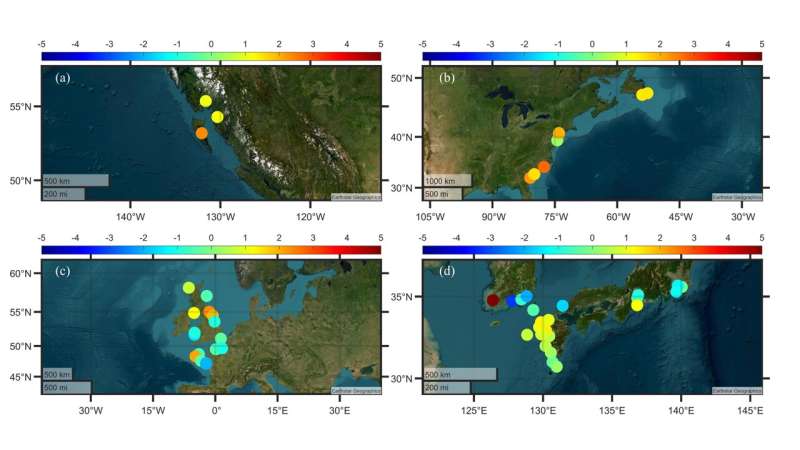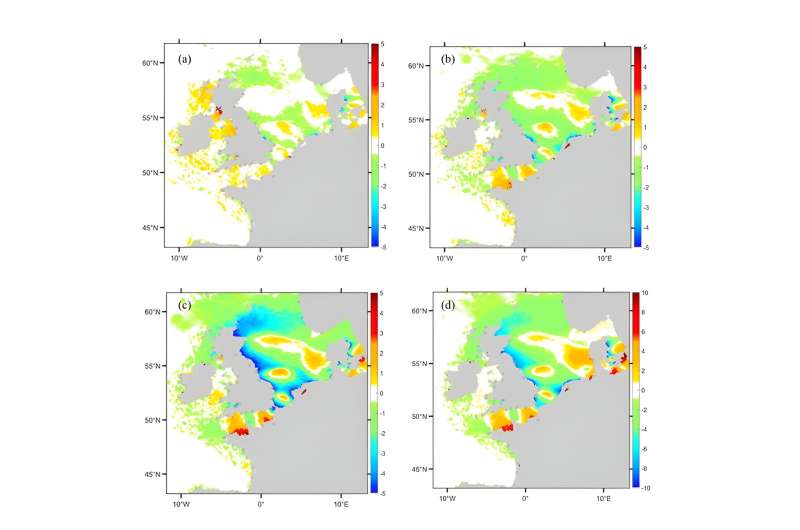This article has been reviewed according to Science X's editorial process and policies. Editors have highlighted the following attributes while ensuring the content's credibility:
fact-checked
peer-reviewed publication
trusted source
proofread
Multi-regional observations and validation of the M₃ ocean tide

The lunar terdiurnal ocean tide has a period of approximately 8.2804 hours, and theoretically has a small amplitude. Its largest equilibrium action term is just 2.56 mm, generally considered to have little impact on shipping or other maritime activities. Thus, it has not received much attention in previous studies, and understanding of the M3 tide's characteristics in various global regions is extremely limited.
However, water level fluctuation caused by the M3 tide in certain areas is much greater than the theoretical tidal amplitude. In addition, the M3 tide may be greatly affected by global sea level rise. Therefore, in order to improve the accuracy of tidal predictions and geodesy, it is important to better understand high-order tides like M3.
A research team led by Professor Jiayi Pan at the College of Geography and Environment of Jiangxi Normal University, including Dr. Adam Devlin, collaborated with Dr. Déborah Idier from the French Geological Survey, using water level observation data from 157 tide gauge stations in multiple regions worldwide, satellite altimetry assimilation data, and numerical simulation to systematically analyze the characteristics of M3 tides in multiple regions.
They also used a numerical model to study the future trends of M3 tides under global warming and sea level rise.
Six key research areas were selected, and hourly tide gauge data were analyzed using a harmonic method with a window of nine years and a time step of three months to determine the M3 amplitude and to produce a continuous time series of the admittance amplitudes of M3. The analysis results show that the M3 amplitude at most locations in the research areas is much larger than the equilibrium tide value.
In the western Pacific region, larger M3 amplitudes were observed in places such as the East China Sea, the northern South China Sea, Surabaya in Indonesia, and the northeastern seas of Australia. The amplitude is relatively moderate on the west coast of Kyushu Island and the central coast of China, but it significantly increases in the Ariake Sea. In the Korea Strait, the M3 amplitude is greater than or equal to 10.0 mm, and gradually decreases in the direction of the eastern Sea of Japan.
The M3 amplitude of TPXO in Tokyo Bay and Nagoya Bay is about half of the observed value. In the North American region, the M3 amplitude in the Northwest Pacific region is between 18.3 and 22.6 mm, but it is much smaller at Bella Bella in the south. In the European continental shelf area, the M3 tide is generally large in the complex coastline of the European continental shelf area, with large variations between sub-regions.

The M3 amplitude in the Scottish Sea area is almost always greater than 20 mm, reaching 39.3 mm in Tobermory. The amplitude in the North Irish Sea is also large, especially in the Liverpool area and its vicinity (27–37 mm), reaching about 52 mm in Millport. Because there is a tidal node nearby, the amplitude of M3 in the Isle of Man Sea area is close to zero. The amplitude in the southern Irish Sea is lower, but it significantly increases in the Bristol Strait.
The investigators also conducted in-depth analysis of data from 61 tide gauge stations that had longer records to determine secular changes in M3 amplitudes. This demonstrated that different geographic areas exhibit different characteristics in the long-term changes in M3 amplitude. For example, in the Northwest Pacific region and along the North Atlantic coast of North America, the M3 amplitude shows a significant positive growth.
At most tide gauge stations in Europe, the M3 amplitude shows a negative long-term trend. This trend has also been confirmed in certain areas in Japan and Korea, where the M3 amplitude shows both strong positive and negative trends. In order to gain a deeper understanding of the impact of sea level rise on M3, the researchers used the MARS model for simulation and analysis. These simulations considered different sea level rise scenarios, ranging from 0.5 m to 3.0 m.
The results show that with an increase in sea level rise, the M3 amplitude in some areas will first increase, but when it reaches a certain threshold, the amplitude will then decrease. This phenomenon is particularly evident in the Irish Sea and Bay of Biscay. In other areas, such as the English Channel, the M3 amplitude continues to increase. Such different sub-regional responses to an essentially uniform forcing highly suggest a significant resonance mechanism on the European Shelf.
These findings provide valuable information about changes in M3 amplitude and also reveal the potential impact of sea level rise on the resonance produced by the European continental shelf sea. This change in resonance may be a key factor causing long-term changes in M3 amplitude. This research result allows us to better understand the impact of sea level rise on the M3 tide.
The first author of this research paper is Dr. Adam Devlin from Jiangxi Normal University (currently working at the University of Hawaii), and the corresponding author is Professor Pan Jiayi from Jiangxi Normal University. Dr. Déborah Idier from the French Geological Survey also participated in the research.
The work is published in the journal Science China Earth Sciences.
More information: Adam Thomas Devlin et al, Multi-regional observations and validation of the M3 ocean tide, Science China Earth Sciences (2023). DOI: 10.1007/s11430-022-1151-0
Journal information: Science China Earth Sciences
Provided by Science China Press




















